Spotify Technology Bundle
How Does Spotify Thrive in the Music Streaming Realm?
Spotify Technology S.A. has revolutionized how we consume audio, from music to podcasts, becoming a dominant force in the digital entertainment industry. Achieving its first full year of operating profit in 2024, Spotify showcased its financial prowess, with a reported €1.4 billion. With hundreds of millions of users, understanding Spotify Technology SWOT Analysis is crucial for anyone looking to understand its trajectory.
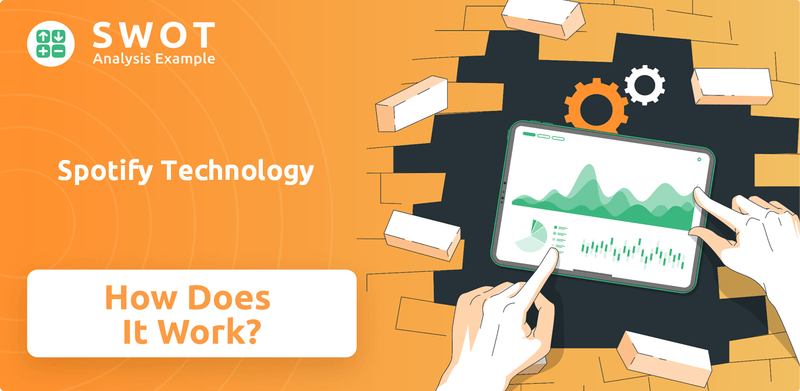
As of Q1 2025, with 678 million MAUs and 268 million premium subscribers, Spotify's continued growth highlights its resilience. This exploration will dissect how Spotify works, examining its core operations, revenue streams, and strategic decisions. We'll uncover the technology behind the music streaming service, from the Spotify algorithm to its user interface, providing insights for investors, users, and industry watchers alike.
What Are the Key Operations Driving Spotify Technology’s Success?
At its core, the value proposition of Spotify centers on providing vast access to audio content through a user-friendly platform. This Marketing Strategy of Spotify Technology serves a global audience with both free (ad-supported) and premium (subscription-based) tiers. The company offers an extensive library of music, podcasts, and audiobooks, catering to diverse listening preferences.
Spotify's operational model leverages advanced technology for content delivery and personalization. Its sophisticated algorithms analyze user listening habits to provide tailored music recommendations, enhancing user engagement and discovery. The company's operations involve extensive technology development, including its ad tech platform and tools for creators.
The company's dual-tier model allows for broad accessibility while incentivizing upgrades to a premium, ad-free experience with additional features. Spotify paid out a record $10 billion in royalties to the music industry in 2024, totaling nearly $60 billion since its founding.
Spotify offers unparalleled access to a vast library of music, podcasts, and audiobooks. It provides a seamless listening experience across various devices, enhancing user engagement and discovery. The platform's freemium model allows broad accessibility while incentivizing premium subscriptions.
Spotify utilizes advanced technology for content delivery and personalization. Its recommendation engine continuously refines user interactions through data-driven recommendations. The company focuses on content acquisition, distribution, and partnerships to expand its reach.
Spotify's technology includes its ad tech platform and tools for creators. The platform's algorithm analyzes user listening habits to provide tailored music recommendations. This enhances user engagement and discovery.
Spotify's supply chain primarily revolves around content acquisition and distribution. It partners with telecom companies, device makers, and streaming bundles to expand its reach. This ensures content availability and user accessibility.
Spotify's freemium model combined with its highly effective personalization engine sets it apart. This results in a unique listening experience, offering unparalleled access to diverse audio content. The data-driven recommendations continuously refine user interactions.
- Unparalleled access to diverse audio content.
- Personalized discovery through advanced algorithms.
- Seamless listening experience across multiple devices.
- Continuous refinement of user interactions.
Spotify Technology SWOT Analysis
- Complete SWOT Breakdown
- Fully Customizable
- Editable in Excel & Word
- Professional Formatting
- Investor-Ready Format
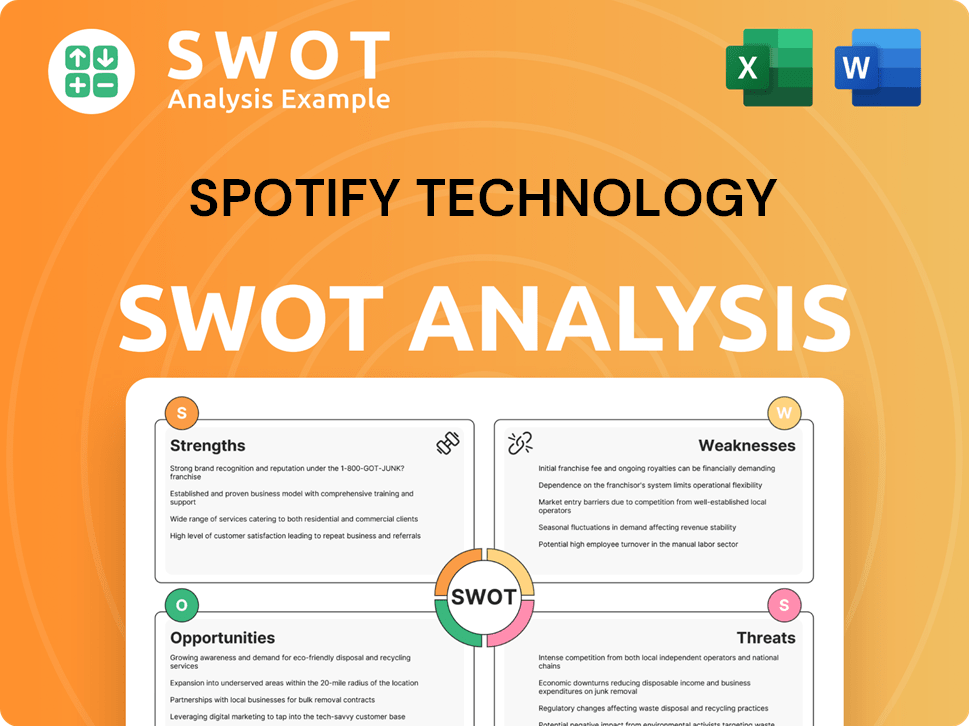
How Does Spotify Technology Make Money?
Understanding how Spotify technology generates revenue involves looking at its primary income streams and monetization strategies. The music streaming platform leverages both subscriptions and advertising to generate income. This approach allows Spotify to cater to a wide range of users, from those who prefer free access to those who want an ad-free experience.
Spotify's financial performance in 2024 showed significant growth, with total revenue reaching €15.67 billion. This represents an impressive 18.3% increase compared to the previous year. This growth is a testament to the effectiveness of its monetization strategies and its ability to attract and retain users.
The main revenue streams and monetization strategies of Spotify technology are broken down as follows:
Premium subscriptions are the cornerstone of Spotify's revenue model. In 2024, this segment generated €13.82 billion, accounting for 88.19% of the total revenue. This represents a 19.5% increase from 2023. As of Q1 2025, premium revenue grew 16% year-over-year to €3.771 billion, showing sustained growth. Subscribers pay a monthly fee for an ad-free experience, offline downloads, and higher audio quality, making it a valuable offering for music lovers.
- Spotify offers various subscription plans to cater to different user needs, including individual, family, and student plans.
- The premium model provides a predictable and substantial revenue stream, crucial for the company's financial stability.
- The continuous growth in premium subscribers indicates strong user satisfaction and loyalty to the platform.
Advertising revenue is the second key component of Spotify's monetization strategy, primarily generated from its free-tier users. In 2024, ad-supported revenue reached €1.85 billion, an increase from €1.68 billion in 2023, accounting for 11.8% of the company's total revenue. In Q1 2025, ad-supported revenue increased by 8% year-over-year. Brands pay for impressions, clicks, and targeted audio/video ads played between songs and podcasts. This revenue stream is essential for supporting the free tier and attracting a broader audience.
- Spotify's advertising platform allows for targeted advertising, enabling brands to reach specific demographics and interests.
- The ad-supported model provides a way for users to access Spotify features without paying a subscription fee.
- Continuous growth in advertising revenue reflects the platform's increasing reach and attractiveness to advertisers.
Spotify employs several innovative strategies to boost revenue and enhance user experience. These include podcast monetization through sponsored episodes and exclusive licensing deals. The integration of audiobooks into premium plans and a la carte sales further diversifies revenue streams. Additionally, Spotify provides tools for artists and podcasters to monetize their content, such as fan donations and premium podcast episodes. The company has also implemented price increases for subscribers in various markets, contributing to its Average Revenue Per User (ARPU) growth. In Q4 2024, Premium ARPU increased by 7% year-over-year at constant currency to €4.85.
- Spotify invests heavily in original content, including podcasts and exclusive music, to attract and retain users.
- Partnerships with artists and content creators provide additional revenue opportunities.
- The platform continuously explores new ways to monetize its vast user base and content library.
For more insights into the ownership structure and financial performance of Spotify technology, you can explore the details in the article about Owners & Shareholders of Spotify Technology.
Spotify Technology PESTLE Analysis
- Covers All 6 PESTLE Categories
- No Research Needed – Save Hours of Work
- Built by Experts, Trusted by Consultants
- Instant Download, Ready to Use
- 100% Editable, Fully Customizable
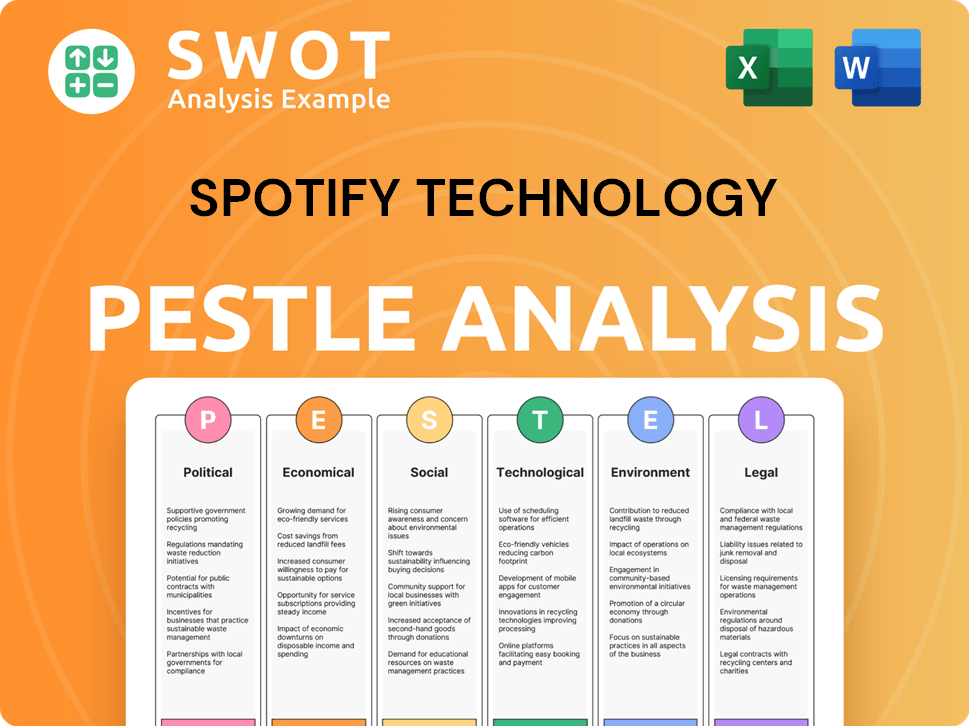
Which Strategic Decisions Have Shaped Spotify Technology’s Business Model?
Since its launch in 2008, the evolution of Spotify has been marked by significant milestones and strategic shifts. A key achievement was reaching its first full year of operating profit in 2024, with €1.4 billion ($1.495 billion), demonstrating the effectiveness of its business model and operational improvements. The company's success continued into 2025, with a record €509 million ($535.6 million) in operating income reported for Q1.
Spotify's strategic moves have focused on expanding beyond music. The company has diversified its content offerings by investing heavily in podcasts and audiobooks. By 2024, Spotify held the second position in the audiobook market, trailing only Amazon's Audible. These moves show Spotify's efforts to increase user engagement and explore new revenue streams.
The company has navigated challenges such as high royalty costs, which reached $10 billion paid to the music industry in 2024, and intense competition from rivals like Apple Music and Amazon Music. Spotify has responded by increasing prices for premium subscriptions and enhancing its premium tiers, including the bundling of audiobooks. Workforce reductions in late 2023 also contributed to improved profitability and operational efficiency.
Spotify achieved its first full year of operating profit in 2024, reaching €1.4 billion ($1.495 billion). The company also reported a record €509 million ($535.6 million) in operating income for Q1 2025, highlighting its strong financial performance. These financial achievements are a testament to the company's maturing business model and operational efficiencies.
Spotify has expanded its content offerings beyond music, focusing on podcasts and audiobooks. It has invested heavily in podcasting, becoming a major platform for spoken-word content, and by 2024, was ranked second in the audiobook market. These moves aim to diversify content offerings and increase user engagement, as discussed in Brief History of Spotify Technology.
Spotify's competitive advantages include strong brand recognition and an extensive content catalog, with over 100 million tracks and 6.5 million podcasts. Its AI-driven personalization algorithms enhance user experience and foster loyalty. The freemium model allows Spotify to attract a wide audience and convert free users into paying subscribers. Economies of scale enable the company to negotiate content deals and invest in new features.
Spotify faces challenges such as managing high royalty costs, which were $10 billion in 2024, and intense competition. The company has responded by increasing premium subscription prices and enhancing its premium tiers. Workforce reductions in late 2023 also contributed to improved profitability and operational efficiency.
Spotify's competitive advantages are multifaceted, including strong brand recognition and an extensive content catalog. The company's technology leadership, particularly its AI-driven personalization algorithms, significantly enhances the user experience and fosters loyalty. The freemium model allows Spotify to attract a wide audience and convert free users into paying subscribers.
- Extensive Content Library: Over 100 million tracks and 6.5 million podcasts.
- AI-Driven Personalization: Tailored recommendations enhance user experience.
- Freemium Model: Attracts a wide audience and drives subscription conversions.
- Economies of Scale: Enables favorable content deals and feature investments.
Spotify Technology Business Model Canvas
- Complete 9-Block Business Model Canvas
- Effortlessly Communicate Your Business Strategy
- Investor-Ready BMC Format
- 100% Editable and Customizable
- Clear and Structured Layout
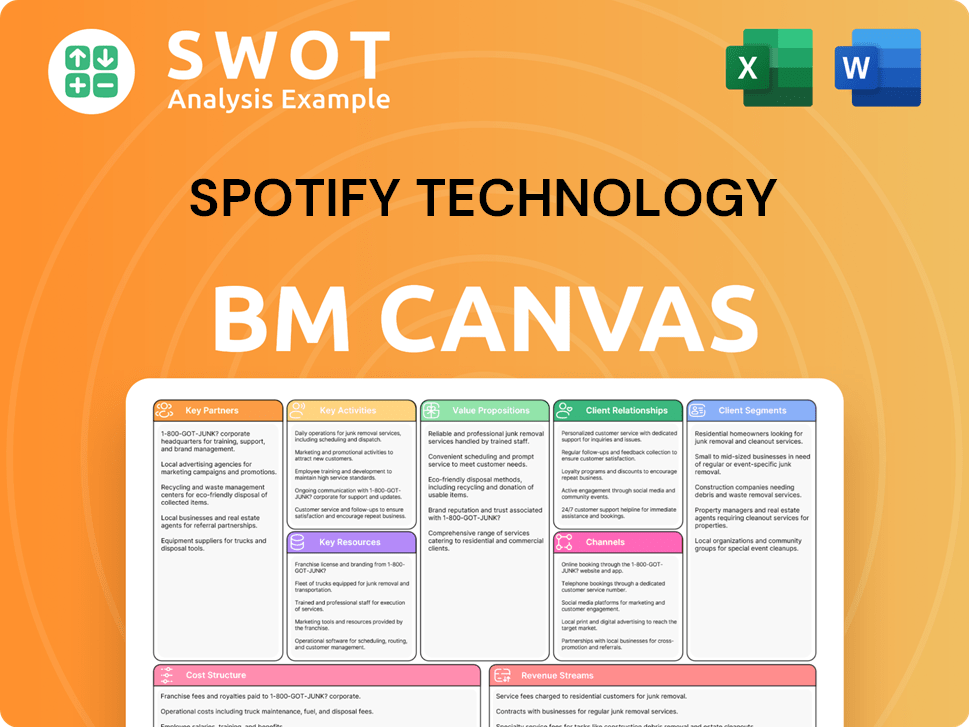
How Is Spotify Technology Positioning Itself for Continued Success?
The [Company Name] maintains a strong position in the global music streaming market. As of Q1 2025, it holds a significant market share and has a vast user base. This success is driven by its extensive reach and the loyalty of its customers worldwide.
Despite its leading status, [Company Name] faces various challenges. These include risks related to regulations, intense competition, and the rapid pace of technological advancements. The company also focuses on effectively converting free users into paying subscribers to drive revenue growth.
The company faces risks from regulatory changes and competition. Technological shifts and the need to convert free users to premium are also key challenges. Slowing ad-supported revenue growth poses another risk.
The company plans to accelerate new feature introductions in 2025. It is investing in podcasts, audiobooks, and exploring new pricing strategies. The CEO aims to reach 1 billion active users.
As of Q1 2025, [Company Name] has 678 million MAUs and 268 million premium subscribers. Europe leads in premium subscribers, followed by North America and Latin America. The company focuses on operational discipline and content diversification.
In 2025, [Company Name] is focusing on rapid execution and new feature introductions. This includes expanding its offerings in podcasts and audiobooks, now integrated into premium plans. The company is also considering new pricing models to boost revenue.
- Continued investment in podcasts and audiobooks.
- Exploration of new pricing strategies, including a 'super-premium' tier.
- Focus on operational discipline and diversified content.
- Aiming for improved margins and sustained growth.
Spotify Technology Porter's Five Forces Analysis
- Covers All 5 Competitive Forces in Detail
- Structured for Consultants, Students, and Founders
- 100% Editable in Microsoft Word & Excel
- Instant Digital Download – Use Immediately
- Compatible with Mac & PC – Fully Unlocked
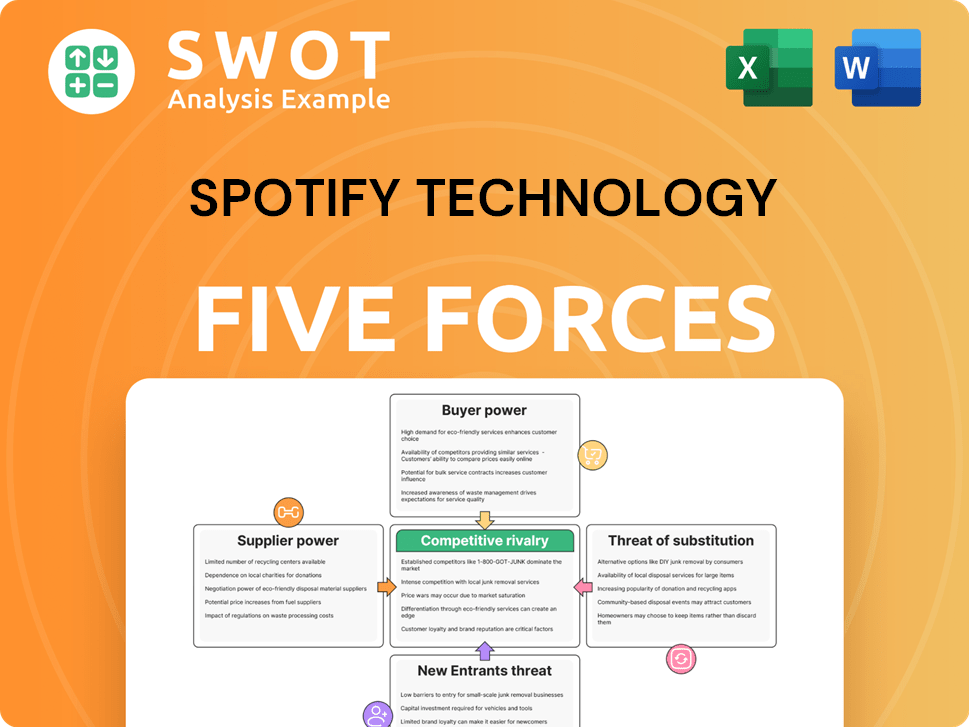
Related Blogs
- What are Mission Vision & Core Values of Spotify Technology Company?
- What is Competitive Landscape of Spotify Technology Company?
- What is Growth Strategy and Future Prospects of Spotify Technology Company?
- What is Sales and Marketing Strategy of Spotify Technology Company?
- What is Brief History of Spotify Technology Company?
- Who Owns Spotify Technology Company?
- What is Customer Demographics and Target Market of Spotify Technology Company?
Disclaimer
All information, articles, and product details provided on this website are for general informational and educational purposes only. We do not claim any ownership over, nor do we intend to infringe upon, any trademarks, copyrights, logos, brand names, or other intellectual property mentioned or depicted on this site. Such intellectual property remains the property of its respective owners, and any references here are made solely for identification or informational purposes, without implying any affiliation, endorsement, or partnership.
We make no representations or warranties, express or implied, regarding the accuracy, completeness, or suitability of any content or products presented. Nothing on this website should be construed as legal, tax, investment, financial, medical, or other professional advice. In addition, no part of this site—including articles or product references—constitutes a solicitation, recommendation, endorsement, advertisement, or offer to buy or sell any securities, franchises, or other financial instruments, particularly in jurisdictions where such activity would be unlawful.
All content is of a general nature and may not address the specific circumstances of any individual or entity. It is not a substitute for professional advice or services. Any actions you take based on the information provided here are strictly at your own risk. You accept full responsibility for any decisions or outcomes arising from your use of this website and agree to release us from any liability in connection with your use of, or reliance upon, the content or products found herein.